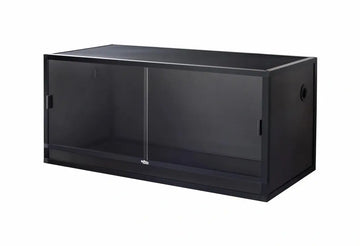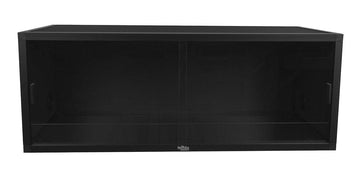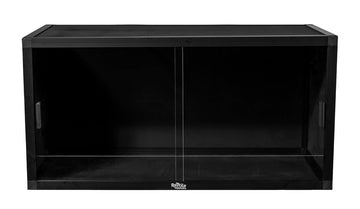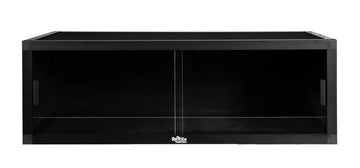The wood turtle (Glyptemys insculpta) is a 5-8” long, semi-aquatic, diurnal reptile found in eastern Canada and the northeastern United States. These turtles prefer cool riparian habitats, where they spend significant time both in the water and foraging on land.
Wood turtles have a flattened, though bumpy shell with distinct growth rings on each scute. The head is blocky and tortoise-like, with large eyes, and their limbs have large scales and no webbing on the toes. The shell is brown-black, with the head and legs being darker. The skin of the neck and undersides of each limb may be red, orange, or yellow.
Wood turtles do well as pets due to their personable dispositions, and with good care, are likely to live 50+ years.
Do not steal turtles from the wild to keep as pets!
Minimum terrarium size for wood turtles
The minimum size enclosure for housing one adult wood turtle should be at least 48”L x 18”W x 21”H, but bigger is always better! Waterland tubs are particularly good for housing wood turtles because they offer a shallow aquatic area and ramp that leads to a generous land area for basking and exploring. Roughly half of your turtle’s enclosure should be water, and just deep enough that the turtle can breathe by stretching tiptoe from the bottom.
If your local climate and housing situation allows, wood turtles tend to do best when housed in an outdoor pond for at least part of the year. Waterland tubs work for this purpose as well, but make sure to top it with a wide mesh lid to keep out potential predators!
Wood turtles can be housed in groups as long as there is no more than one male per group, and the size of the enclosure is proportionally increased.
Do wood turtles need UVB?
Yes! Wood turtles require exposure to appropriate amounts of UVB in order to maintain good health and wellbeing. Providing UVB lighting to your turtle offers several benefits, including all of the vitamin D that their body needs, better appetite and activity, and a stronger immune system.
The best UVB bulbs for wood turtles are:
- Zoo Med Reptisun T5 HO 5.0
- Arcadia Forest 6%
Yes, brand matters!
The UVB bulb should be half the length of the enclosure and housed in a reflective fixture like the Arcadia ProT5 or Vivarium Electronics. Place the lamp close to the heat lamps, about 8-11” above the basking platform if there is mesh obstruction, and 13-15” away if no mesh. UVB bulbs decay over time, so don’t forget to replace your bulb every 12 months to maintain good performance.
It’s best practice to provide extra illumination via a strong LED or T5 HO 6500K daylight lamp. This helps better replicate daylight and is also good for any live plants you may be using.
Lights should be on for 16 hours/day during summer and 9 hours/day during winter. However, if you are housing your turtle outdoors in a pond, then supplementary lighting is not required.
Best temperature for wood turtles
Unlike mammals, which control their own body temperature internally, wood turtles and other reptiles rely on external sources to regulate their body temperature and metabolism.
Different reptiles require different temperatures for best health. For wood turtles, the basking area should have an air temperature of 85-90°F, and the water should stay nice and cool between 60-70°F. Measure basking temperature with a digital probe thermometer, and water temperature with a high-quality aquarium thermometer.
Provide basking heat for your turtle with a halogen flood heat lamp on one side of the enclosure, positioned directly over the basking area at the same height as the UVB lamp. Avoid ceramic heat emitters (CHEs), red bulbs, or blue bulbs, as these are not as effective. Use a higher wattage bulb if you need more heat, or use a plug-in lamp dimmer if it’s too warm.
If you are housing your turtle outdoors in an appropriate climate, heating equipment is not required. However, whether you are keeping your turtle indoors or outdoors, accommodations must be made for winter hibernation.
Water management for wood turtles
Given that wood turtles are semi-aquatic animals, the water portion of their enclosure is a pretty significant part of their life. In other words, you’ll be essentially maintaining a small pond or aquarium with an accessible land area. Your turtle’s water must be kept as clean as possible to promote good health.
For filtration, you will need a canister-style filter capable of handling at least 2x the amount of water in the enclosure. For example, if you have an enclosure with 40 gallons of water, you will need a filter rated for at least 80 gallons of water. This is another aspect of your setup where it’s very important to invest in excellent equipment!
Make sure the filter is low-flow for minimal water disturbance — a strong current will stress your turtle! Alternatively, place a stone or other decor under the filter’s outflow to diffuse the current.
You will also need to perform routine water changes. Once every 1-2 weeks, remove and replace approximately 30% of the enclosure’s total water volume. As essential as filters are, periodically removing “old” water and replacing it with “new” water helps prevent toxic compounds from building up. To make water changes easier, use a siphon or water pump.
Both indoor and outdoor ponds require filtration and routine water changes.
Best substrate for wood turtles
Wood turtles spend a significant amount of time on land and like to burrow, so it’s important to have an area of sandy soil within easy access at all times. Zoo Med Reptisoil works well for this purpose, or you can create your own mix of approximately 80% clean topsoil and 20% play sand (measured by volume).
Substrate isn’t required for the pond part of the enclosure, but it does improve its appearance and functionality if you want to plant live plants. Use fine sand for this application. Avoid gravel and small pebbles, as they can become life-threatening if ingested.
Leaf litter and sphagnum moss can be used as part of the substrate on land or in the water.
How to decorate a wood turtle terrarium
Decor is about more than just creating an attractive enclosure — it’s also about boosting the enclosure’s functionality. Here are some ideas:
- live/artificial plants
- driftwood
- hollow logs
- terracotta pots
Driftwood in particular is likely to be appreciated by wood turtles. Just make sure that the turtle can’t get stuck! Also note that any artificial plants need to be sturdy enough not to break if your turtle tries to eat them.
What to feed to a wood turtles
Wood turtles are omnivorous, which means that they need both plant- and animal-based foods in their diet to get the nutrition that they need. Here is a general feeding schedule to follow:
Wood turtles younger than 6 months:
- 50% protein / 50% vegetables
- protein food or pellets daily
- vegetable food daily
Wood turtles between 6-12 months:
- 50% protein / 50% vegetables
- protein food or pellets every other day
- vegetable food daily
Wood turtles older than 1 year:
- 25% protein / 75% vegetables
- protein food or pellets 2-3x/week
- vegetable food daily
Animal-based foods for wood turtles: crickets, earthworms, dubias, freeze-dried shrimp/krill, frozen bloodworms, silkworms, snails
Vegetable foods for wood turtles: collard greens, dandelion greens + flowers, endive, green leaf lettuce, kale, red leaf lettuce, romaine lettuce, raw grated squash, carrots, green beans, raw grated sweet potato, duckweed, water hyacinth, water lettuce, algae wafers
Pellets for wood turtles: Omega One Juvenile Turtle Pellets, Omega One Adult Turtle Sticks, Tetra ReptoMin, Zoo Med Natural Aquatic Turtle Food, Mazuri Aquatic Turtle Diet
A portion of chopped/shredded vegetables should be roughly the same size as the turtle’s shell. A portion of pellets or protein food should be roughly the same size as the turtle’s head.
For extra calcium, your turtle should have access to a cuttlebone or calcium block at all times.
How to handle your wood turtles
Unlike some other reptiles, turtles aren’t the kind of pet that you can handle regularly. If you want to try bonding with your turtle, try tong-feeding it instead!
*This care sheet contains only very basic information. Although it’s a good introduction, please further your research with high-quality sources. The more you know, the better you will be able to care for your pet!
"Wood Turtle, Glyptemys insculpta (LeConte, 1830)" by Misenus1 is licensed under CC BY-NC-SA 2.0











